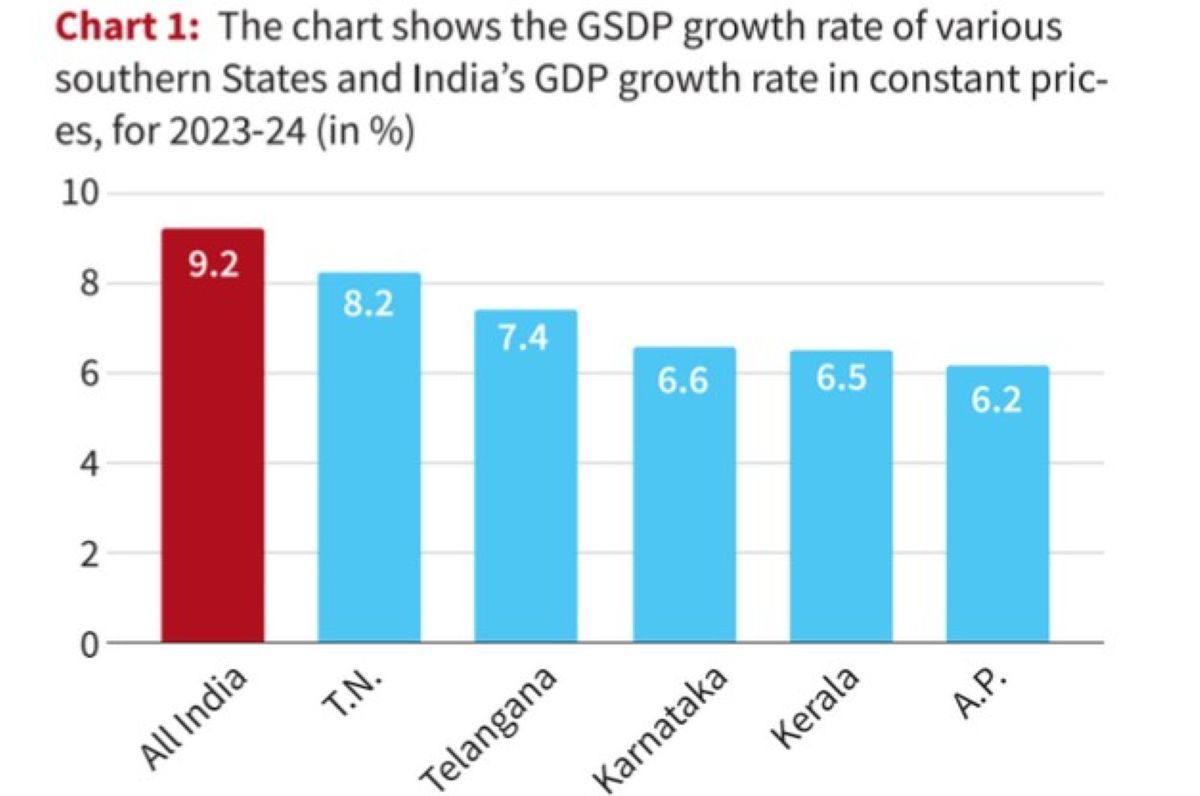
New Delhi, May 30, 2025 —
India’s economic growth for the financial year 2024–25 (FY25) slowed to 6.5%, marking the lowest annual GDP growth rate in four years, according to data released by the National Statistical Office (NSO) on Thursday. Despite the year-long deceleration, the gross domestic product (GDP) for the fourth quarter (January–March 2025) came in at a robust 7.4%, exceeding market expectations and signaling resilience in Asia’s third-largest economy.
The FY25 GDP growth rate fell below the FY24 figure of 7% and the post-COVID rebound of 9.1% in FY23. Nonetheless, the Q4 performance has brought some relief, especially in light of global headwinds, sluggish exports, and geopolitical uncertainties.
Q4 GDP Beats Expectations With 7.4% Expansion
The 7.4% GDP growth in Q4 FY25 is the fastest quarterly growth since Q4 FY23, driven primarily by a rebound in manufacturing and construction activity, increased rural consumption, and sustained government capital expenditure.
🚨 #JUSTIN India’s Q4 FY 2024-25 GDP growth is 7.4%, the highest previous fiscal year🔥.
The Nominal GDP Growth stood at 10.8%.
Real GDP estimated growth is 6.5% in FY 2024-25.#GDP #IndianEconomy #IndiaGrowth #Economy pic.twitter.com/5X8f6yP2Yq— Everyday Pursuits (@evrydaypursuit) May 30, 2025
Source: Everyday Pursuits
Economists had largely anticipated Q4 growth to remain under 7%, given weak global cues and muted demand across several export-linked sectors. However, higher-than-expected growth in the manufacturing sector (up 8.9%) and a significant uptick in construction (up 9.9%) contributed to the quarterly surprise.
“India’s economy continues to demonstrate resilience despite the global slowdown and geopolitical challenges,” said Chief Economic Adviser V. Anantha Nageswaran. “Strong domestic demand and reforms-led investments are bearing fruit.”
Annual Growth Dips to 6.5%: The Slowest Since FY21
While the strong Q4 print adds a layer of optimism, the overall GDP growth for FY25 stood at 6.5%, the lowest since FY21, when the economy was still recovering from the pandemic shock.
Read Also: India’s Economy Hits 6.7% Growth, Surpasses Japan to Become World’s 4th Largest Economy
Source: NDTV
Factors Behind Slower Annual Growth:
- Sluggish export performance due to global economic slowdown and trade tensions.
- Monetary tightening and high interest rates in major economies, impacting external demand.
- High base effect from previous years of strong recovery post-COVID.
- Moderation in private consumption due to persistent inflation and elevated food prices.
Despite these challenges, India remains among the fastest-growing major economies globally, with China and the U.S. growing at slower rates in the same period.
- Sector-Wise Breakdown: Who Led and Who Lagged
- Here’s a closer look at the sectoral performance across FY25:
Top Performing Sectors:
- Construction: +9.9% in Q4, driven by infra push and housing demand.
- Manufacturing: +8.9% in Q4, recovering from last year’s slowdown.
- Mining and quarrying: +7.5% in Q4.
Lagging Sectors:
- Agriculture: Grew only 0.6% in Q4 due to unseasonal rains and lower rabi output.
- Financial services, real estate & professional services: Slowed to 5.8%.
- Public administration, defense & other services: Registered 7.8%, slower than prior quarters.
The Gross Value Added (GVA)—a key measure of economic productivity that excludes taxes and subsidies—grew by 6.4% in Q4 and 6.2% in FY25, slightly lower than headline GDP figures.
Government Reaction and Future Outlook
Finance Minister Nirmala Sitharaman welcomed the Q4 numbers, stating that India is on track for “strong and sustained growth driven by structural reforms and fiscal prudence.”
The government attributed the strong finish in Q4 to the infrastructure-led growth model, increased public investment, and production-linked incentive (PLI) schemes spurring private sector participation.
“The economy remains fundamentally strong. Inflation is under control, fiscal discipline is maintained, and domestic demand is solid,” Sitharaman said.
Looking ahead, the Reserve Bank of India (RBI) has projected 6.5% GDP growth for FY26, maintaining a cautiously optimistic tone. The central bank is expected to keep policy rates steady in the upcoming monetary policy meeting, balancing inflation risks and growth imperatives.
Markets Rally But Cracks Remain
Even as the GDP numbers were released, stock markets continued their bullish trend, with the Sensex surging over 10,000 points since April lows. Investor sentiment remains buoyant ahead of the general elections and on the back of strong domestic flows.
However, analysts warn that corporate earnings are not fully aligned with market optimism. The Nifty Q4 earnings growth stands at just under 6% YoY, raising concerns about overvaluation and sustainability of the current rally.
“Markets may be running ahead of fundamentals. Earnings need to catch up for this rally to be justified,” said Dhiraj Relli, CEO, HDFC Securities.
Global Headwinds and Domestic Challenges
Despite the encouraging Q4 GDP figures, India faces several external and internal challenges:
Global:
- Weak global trade and continued volatility in commodity markets.
- Geopolitical tensions, especially the Russia-Ukraine war and China-Taiwan concerns.
- Tight financial conditions in the U.S. and Europe.
Domestic:
- Slow job creation, particularly in the formal sector.
- Sticky food inflation, despite some moderation in fuel prices.
- Dependence on government capex, with limited private sector investment in some areas.
Additionally, climate-related disruptions such as delayed monsoons could affect rural demand and agriculture going forward.
IMF, Moody’s Offer Mixed Outlooks
The International Monetary Fund (IMF) remains bullish on India, projecting the country will become the third-largest economy by 2027 and reach a GDP size of $4.18 trillion by end-2025, overtaking Japan.
On the flip side, Moody’s Investors Service recently cut India’s growth forecast for 2025 to 6.3%, citing global headwinds and a slowdown in government spending post-elections.
Conclusion: Resilience Amidst Caution
India’s FY25 GDP data presents a tale of two halves: a year marked by gradual slowdown and a surprising Q4 surge that underlines the economy’s resilience. While the full-year growth of 6.5% is modest by recent standards, the 7.4% Q4 figure has helped restore investor and policymaker confidence.
However, the path forward remains complex. Policymakers will need to strike a balance between stimulating growth, keeping inflation in check, and ensuring job creation, particularly as India heads into a crucial election year.
As the global economic environment continues to evolve, India’s domestic fundamentals — consumption, capex, and innovation — will be key to sustaining momentum and achieving long-term economic goals.







